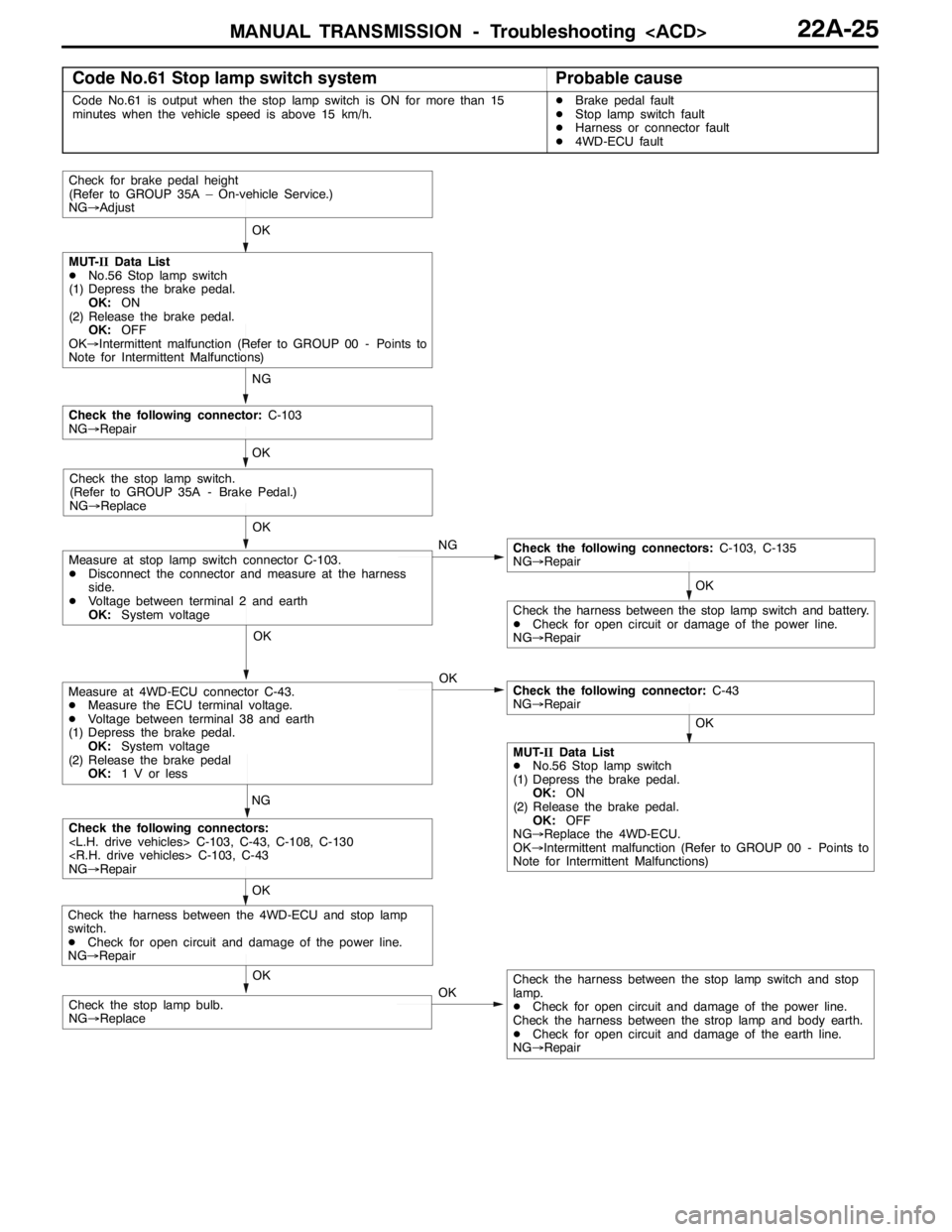Page 700 of 1449

ENGINE COOLING -Thermostat14-12
INSTALLATION SERVICE POINTS
"AATHERMOSTAT INSTALLATION
Install the thermostat being careful not to fold over or scratch
the rubber ring.
Caution
Make absolutely sure that no oil is adhering to the rubber
ring of the thermostat. In addition, be careful not to fold
over or scratch the rubber ring when inserting. If the
rubber ring is damage, replace the thermostat.
"BARADIATOR UPPER HOSE CONNECTION
1. Insert each hose as far as the projection of the water
outlet fitting.
2. Align the mating marks on the radiator hose and hose
clamp, and then connect the radiator hose.
INSPECTION
THERMOSTAT CHECK
1. Immerse the thermostat in water, and heat the water while
stirring. Check the thermostat valve opening temperature.
Standard value:
Valve opening temperature: 80±1.5_C
2. Check that the amount of valve lift is at the standard value
when the water is at the full-opening temperature.
Standard value:
Full-opening temperature: 93_C
Amount of valve lift: 9.5 mm or more
NOTE
Measure the valve height when the thermostat is fully
closed, and use this measurement to calculate the valve
height when the thermostat is fully open.
Valve lift
Page 740 of 1449

ENGINE ELECTRICAL -Charging System16-8
(14)If the voltage reading conforms to the value
in the voltage regulation, then the voltage
regulator is operating normally.
If the voltage is not within the standard value,
there is a malfunction of the voltage regulator
or of the alternator.
(15)After the test, lower the engine speed to the
idle speed.
(16)Turn the ignition switch to the “LOCK” (OFF)
position.(17)Remove the tachometer or the MUT-II.
(18)Disconnect the negative battery cable.
(19)Disconnect the ammeter and voltmeter.
(20)Connect the alternator output wire to the
alternator “B” terminal.
(21)Remove the special tool, and return the
connector to the original condition.
(22)Connect the negative battery cable.
Voltage Regulation Table
Standard value:
Inspection terminalVoltage regulator ambient temperature_CVoltage V
Terminal “S”-2014.2 - 15.4
2013.9 - 14.9
6013.4 - 14.6
8013.1 - 14.5
WAVEFORM CHECK USING AN ANALYZER
MEASUREMENT METHOD
Connect the analyzer special patterns pick-up to the alternator
B terminal.
STANDARD WAVEFORM
Observation Conditions
FUNCTIONSPECIAL PATTERNS
PATTERN HEIGHTVARIABLE
VARIABLE knobAdjust while viewing the wave-
form.
PATTERN SELECTORRASTER
Engine speedCurb idle speed
AlternatorSpecial
patterns
pickupAnalyzer
B terminal
Page 763 of 1449
ENGINE ELECTRICAL -Ignition System16-31
STANDARD WAVEFORM
Observation Conditions
FunctionSecondary
Pattern heightHigh (or Low)
Pattern selectorRaster
Engine revolutionsCurb idle speed
kV
Secondary
ignition
voltage
waveformIgnition voltage
(point D)
Dwell
section
Point CSpark line (point A)
Wave damping
reduction section
(point B)
Time
Observation Condition (The only change from above condition is the pattern selector.)
Pattern selectorDisplay
Secondary
ignition
voltage
waveformkV
No. 4 cylinder
No. 2 cylinder
ignition noiseNo. 1 cylinderNo. 3 cylinder
ignition noise
Neutral section 0
2Time
Page 764 of 1449

ENGINE ELECTRICAL -Ignition System16-32
WAVEFORM OBSERVATION POINTS
Point A: The height, length and slope of the spark line show the following trends (Refer to abnormal
waveform examples, 1, 2, 3 and 4).
Spark linePlug gapCondition of
electrodeCompression
forceConcentration of
air mixtureIgnition timingSpark plug
cable
LengthLongSmallNormalLowRichAdvancedLeak
ShortLargeLarge wearHighLeanRetardedHigh
resistance
HeightHighLargeLarge wearHighLeanRetardedHigh
resistance
LowSmallNormalLowRichAdvancedLeak
SlopeLargePlug is fouled----
Point B: Number of vibration in reduction vibration section (Refer to abnormal waveform example 5)
Number of vibrationsCoil and condenser
Three or moreNormal
Except aboveAbnormal
Point C: Number of vibrations at beginning of dwell section (Refer to abnormal waveform example 5)
Number of vibrationsCoil
5 - 6 or higherNormal
Except aboveAbnormal
Point D: Ignition voltage height (distribution per each cylinder) shows the following trends.
Ignition
voltagePlug gapCondition of
electrodeCompression
forceConcentration of
air mixtureIgnition timingSpark plug cable
HighLargeLarge wearHighLeanRetardedHigh resistance
LowSmallNormalLowRichAdvancedLeak
Page 793 of 1449

CLUTCH -General Information/Service Specifications/Lubricants/On-vehicle Service21A-3
GENERAL INFORMATION
The clutch is a dry single-disc, diaphragm type;
hydraulic pressure is used for the clutch control.
SERVICE SPECIFICATIONS
ItemsStandard value
Clutch pedal height mm202.1 - 206.1
173.5 - 177.5
Clutch pedal clevis pin play mm1-3
Clutch pedal free play mm4-13
Distance between the clutch pedal and the toeboard
when the clutch is disengaged mm114.3 or more
100 or more
LUBRICANTS
ItemsSpecified lubricantsQuantity
Clutch fluidBrake fluid DOT3 or DOT4As required
Push rod assemblyRubber grease
Boot
Release cylinder push rodMITSUBISHI genuine grease Part No.
0101011
ON-VEHICLE SERVICE
CLUTCH PEDAL INSPECTION AND
ADJUSTMENT
1. Turn up the carpet, etc. under the clutch pedal.
2. Measure the clutch pedal height and the clutch pedal
clevis pin play.
Standard value (A):
202.1 - 206.1 mm
173.5 - 177.5 mm
Standard value (B): 1 - 3 mm
Clutch pedal height
A
A
Clutch pedal
stopper
Clutch pedal clevis pin play
B
Page 794 of 1449

CLUTCH -On-Vehicle Service21A-4
3. If the height of the clutch pedal is outside the standard
value, loosen the setting nut to adjust the pedal height
to the standard value.
Caution
Do not push in the master cylinder push rod at this
time, otherwise the clutch will not operate properly.
4. After completing the adjustments, confirm that the clutch
pedal free play (measured at the face of the pedal pad)
and the distance between the clutch pedal (the face of
the pedal pad) and the clutch pedal stopper or toeboard
when the clutch is disengaged are within the standard
value ranges.
Standard value (C): 4 - 13 mm
Standard value (D):
114.3 mm or more
100 mm or more
5. If the clutch pedal free play and the distance between
the clutch pedal and the clutch pedal stopper or toeboard
when the clutch is disengaged do not agree with the
standard values, it is probably the result of either air in
the hydraulic system or a faulty master cylinder, clutch
cylinder or clutch. Bleed the air, or disassemble and inspect
the master cylinder, clutch cylinder or clutch.
6. Turn back the carpet, etc.
BLEEDING
Specified fluid: Brake fluid DOT 3 or DOT 4
Caution
Use the specified brake fluid. Avoid using a mixture
of the specified fluid and other fluid.
CLUTCH PEDAL POSITION SWITCH
ADJUSTMENT
1. Adjust the clutch pedal. (Refer to P. 21A-3).
2. Disconnect the connector from clutch pedal position
switch.
3. Loosen the clutch pedal position switch by rotating approx.
quarter turn to counterclockwise.
4. Fix the clutch pedal in full stroke.
Clutch pedal Setting nut
13±2 N·m
Clutch pedal clevis pin play
C
Clutch
pedal
stopper
D D
Page 833 of 1449

MANUAL TRANSMISSION - Troubleshooting 22A-25
Code No.61 Stop lamp switch systemProbable cause
Code No.61 is output when the stop lamp switch is ON for more than 15
minutes when the vehicle speed is above 15 km/h.DBrake pedal fault
DStop lamp switch fault
DHarness or connector fault
D4WD-ECU fault
OK
OK
OK
NG
OK
Check for brake pedal height
(Refer to GROUP 35A – On-vehicle Service.)
NG→Adjust
NG
MUT-IIData List
DNo.56 Stop lamp switch
(1) Depress the brake pedal.
OK:ON
(2) Release the brake pedal.
OK:OFF
OK→Intermittent malfunction (Refer to GROUP 00 - Points to
Note for Intermittent Malfunctions)
OK
Check the following connector:C-103
NG→Repair
Check the stop lamp switch.
(Refer to GROUP 35A - Brake Pedal.)
NG→Replace
NG
OK
Check the following connectors:C-103, C-135
NG→Repair
Check the harness between the stop lamp switch and battery.
DCheck for open circuit or damage of the power line.
NG→Repair
OK
Measure at stop lamp switch connector C-103.
DDisconnect the connector and measure at the harness
side.
DVoltage between terminal 2 and earth
OK:System voltage
Measure at 4WD-ECU connector C-43.
DMeasure the ECU terminal voltage.
DVoltage between terminal 38 and earth
(1) Depress the brake pedal.
OK:System voltage
(2) Release the brake pedal
OK:1 V or less
OK
Check the following connectors:
C-103, C-43, C-108, C-130
C-103, C-43
NG→Repair
OKCheck the harness between the stop lamp switch and stop
lamp.
DCheck for open circuit and damage of the power line.
Check the harness between the strop lamp and body earth.
DCheck for open circuit and damage of the earth line.
NG→Repair
Check the harness between the 4WD-ECU and stop lamp
switch.
DCheck for open circuit and damage of the power line.
NG→Repair
Check the following connector:C-43
NG→Repair
MUT-IIData List
DNo.56 Stop lamp switch
(1) Depress the brake pedal.
OK:ON
(2) Release the brake pedal.
OK:OFF
NG→Replace the 4WD-ECU.
OK→Intermittent malfunction (Refer to GROUP 00 - Points to
Note for Intermittent Malfunctions)
OK
Check the stop lamp bulb.
NG→Replace
Page 953 of 1449
REAR AXLE -Special Tools27B-7
Tool UseName Number
MB990850End yoke holderDRemoval of the self-locking nut
DAdjustment of the drive pinion turning
torque
MB990339Bearing pullerDrive pinion rear bearing inner race removal
MB990648Bearing remover
B A
MB990835
A: MB990836
B: MB990392Drive pinion setting
gauge set
A: Drive pinion
gauge assem-
bly
B: Cylinder
gaugeAdjustment of drive pinion height
MB990988Side gear holding
tool setMeasurement of clutch plate preload (vehicles
with mechanical LSD)
MB990728Side & rear bearing
inner race installerPress-fitting of drive pinion rear bearing inner
race
MB990727Oil seal installerPress-fitting of drive pinion oil seal
MB990813Ta pRemoval of adhesive